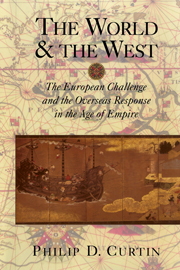Book contents
- Frontmatter
- Contents
- Preface
- Part One Conquest
- Part Two Culture Change and Imperial Rule
- Part Three Conversion
- 7 Christian Missions in East Africa
- 8 Varieties of Defensive Modernization
- 9 Meiji Japan: Revolutionary Modernization
- 10 Ottoman Reactions to the West
- Part Four Independence and the Liquidation of Empires
- Index
9 - Meiji Japan: Revolutionary Modernization
Published online by Cambridge University Press: 05 June 2012
- Frontmatter
- Contents
- Preface
- Part One Conquest
- Part Two Culture Change and Imperial Rule
- Part Three Conversion
- 7 Christian Missions in East Africa
- 8 Varieties of Defensive Modernization
- 9 Meiji Japan: Revolutionary Modernization
- 10 Ottoman Reactions to the West
- Part Four Independence and the Liquidation of Empires
- Index
Summary
Japan is the first and most successful non-Western nation to achieve the high production and consumption pioneered by the West. Many historians used to regard the industrial revolution as a uniquely Western achievement and considered Japan's industrial success as a purely imitative borrowing of what the West had invented. Europe's comparative place in world history in the 1800s now seems less unique than historians thought only a few decades ago. Historians of Japan have recently showed that much of the social and economic base of Japanese industrialization was already in place by the late 1700s.
The Tokugawa Heritage
The Western challenge was first of all military, but superior weapons were not necessarily available to Europeans only, as we have seen from the examples of secondary empires as diverse as those of Mutesa and Kamehameha. Japan first faced the threat of new military technology in the late 1500s, when the “gunpowder empires” were coming to power here and there throughout the world. Japan, too, adopted gunpowder weapons, but its military innovations included the use of massed, disciplined infantry, with or without guns, and the construction of castles capable of defense against artillery, changes parallel to similar innovations in Europe. The Europeans who appeared in Japan in that century, Christian missionaries and others, were no serious threat. In the early 1600s, the new military technology, only partly borrowed from the outside, made possible the unification of Japan by the Tokugawa shogunate.
- Type
- Chapter
- Information
- The World and the WestThe European Challenge and the Overseas Response in the Age of Empire, pp. 156 - 172Publisher: Cambridge University PressPrint publication year: 2000



